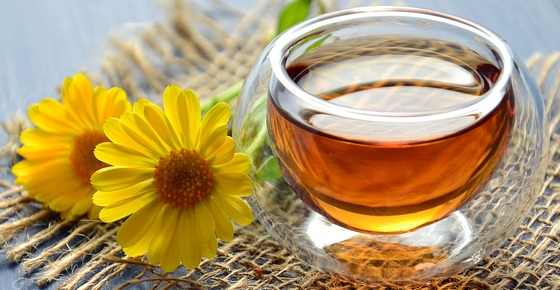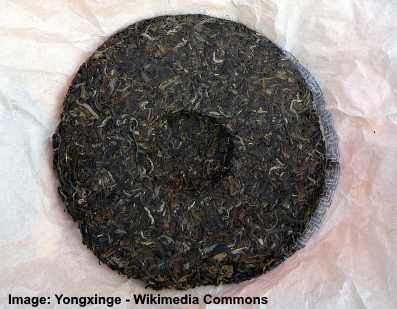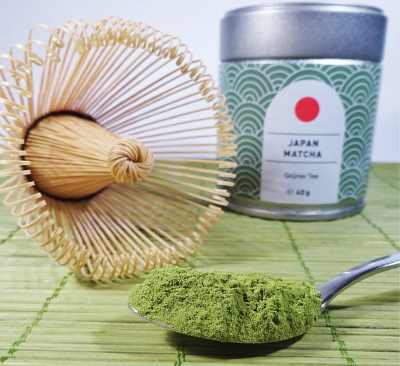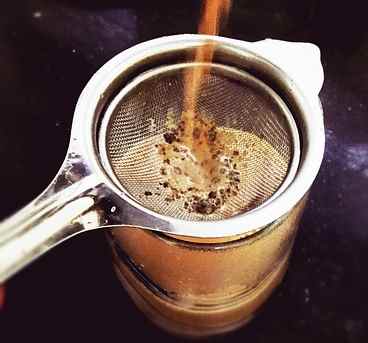Types of Tea: Varieties of Tea With Their Flavor, Caffeine Content and More

All types of true tea come from the leaves of the plant Camellia sinensis. Black tea, green tea, white tea, and oolong tea are just some examples of popular kinds of teas all from the same leaf. From these tea varieties, tea producers can create teas with a unique taste, color, and aroma. Depending on how the tea leaves are processed, tea can have varying levels of caffeine.
Tea is mainly grown in Asian countries such as China, India, Sri Lanka, Nepal, and Taiwan. The most popular types of black tea are Darjeeling and Assam, which come from India, and Ceylon from Sri Lanka. China is the world’s largest tea producer where Lapsang souchong and varieties of green tea are very popular.
Many types of tea, both from the Camellia sinensis plant and from herbal infusions are consumed for their health benefits.
Types of Tea
Before we look at the many available varieties of tea, it’s important to distinguish between “true teas” and “herbal teas.”
The only varieties of tea that are classed as true tea are those made from leaves of the Camellia sinensis plant. Black tea, oolong tea, green tea, and white tea are the only true types of tea.
Tea also contains caffeine. Studies have found that brewed white, black, and green teas can contain between 14 to 61 mg of caffeine per 6 oz. serving. Allowing the tea to brew for a longer time increases the caffeine content. (1)
Tea leaves actually contain more caffeine concentration than coffee beans. However, more coffee beans are used to brew coffee than leaves used to make tea. This means that a cup of coffee has more caffeine than black tea, oolong, tea, or white tea. (2)
Although not technically classed as a true tea, herbal teas are very popular because they contain no caffeine. On the list of popular herbal teas are ones such as chamomile tea, ginger tea, rooibos tea, and mint tea. These herbal infusions are made by putting plant leaves, flowers, roots, or bark in hot water.
Let’s look in more detail at the 6 main types of tea, starting with the most popular beverage in the world – black tea.
Black Tea
Black tea is the most commonly consumed type of tea. In fact, black tea is the most commonly consumed beverage on the planet apart from water.
All types of black tea are made by exposing the tea leaves to the air. This process causes the leaves to oxidize and turn brown to black, and is also referred to as fermenting the leaves. The brown tea leaves are then heated, dried, and crushed. (3)
Black tea has more caffeine than oolong tea, green tea, or white tea. A one 8-oz. cup of black tea contains between 25 and 48 mg of caffeine. (2)
China, India, and Sri Lanka (formerly known as Ceylon) are the world’s largest producers of black tea. Different types of black tea are usually named after the region they are from.
For example, Darjeeling tea from India has a light brown color with floral and fruity aromas and flavors. Assam tea, also from India, is a darker variety of tea with a more intense color and flavor. People generally enjoy Assam black tea hot with a splash of milk to balance the flavor.
Ceylon tea from Sri Lanka is a medium to strong variety of black tea depending on the brewing process. This type of tea has light citrusy flavors and is often the type of tea used to make iced tea.
There are many varieties of black tea that come from China. Dianhong tea from the Yunnan province is sometimes called “red tea” and has a strong aroma and full-bodied taste that is somewhat astringent.
The varieties of black tea mean that most people can find a type of tea that they enjoy drinking. Some black teas are also blended to create different kinds of tea with different flavors and aromas. Later in the article, you can read about types of blended black teas such as Earl Grey tea, Chai tea, and breakfast teas. (4, 5)
Pu’er Tea
Pu’er tea (also written as pu-erh) is a type of tea originating from the Yunnan province in China and is reported to have many health benefits.
There are two types of pu’er tea – raw pu’er tea and aged, or ripened pu’er tea. To make the raw variety, tea leaves are treated with high temperatures just after picking. This gets rid of enzymes in the leaves that usually oxidize. Raw pu’er tea is typically consumed as a green type of tea.
Ripened pu’er tea is called a post-fermented tea. Tea leaves from the assamica variety of the Camellia sinensis plant are dried in the sun and then pressed into a “cake.” This cake is allowed to age naturally where it develops polyphenols that have antioxidant activity. The tea is aged for many years with some of the most expensive pu’er tea varieties being aged for up to 50 years. (6)
Pu’er tea, as with all type of black and green tea, contains caffeine. The amount of caffeine in pu’er tea varies depending on the aging process.
The taste and aromas of raw pu’er tea are similar to that of green tea. Aged or ripened pu’er tea resembles the taste and look of black teas with the tea having a dark red color.
You can buy pu’er tea in leaf form, in tea bags, or in small tea cakes. Some varieties of aged pu’er tea are some of the most expensive types of tea in the world.
Green Tea
Green tea is a type of unfermented tea and is one of the most popular types of tea in the world.
Green tea is produced by drying freshly picked tea leaves either in the sun, in ovens, or on pans. Some types of green tea are also processed by steaming. The processing methods involved don’t allow green tea leaves to oxidize and they retain all their healthy polyphenols. (7)
As green tea dries, tea masters roll the leaves up into small balls that resemble pearls. Other drying methods result in types of green tea that look like small twigs.
Compared to black tea, green tea has slightly less caffeine per cup with only 25 – 29 mg of caffeine in 8 oz. of tea.
There are a number of varieties of green tea, all with varying aromas and tastes.
One of the most popular kinds of green tea is Sencha green tea from Japan. Some people describe the taste of Sencha tea as fruity and floral with grassy overtones. The tea is usually a light green color. There are many varieties of Sencha tea such as Fukamushi Sencha and Hachijuhachiya Sencha.
One of the types of green tea that resembles pearls is gunpowder tea from China. This type of tea has a stronger flavor than that other green tea varieties. This tea produces a green tea with smoky, grassy flavors with a strong kick.
Other types of green tea include Gyokuro green tea from Japan, Longjing (Dragon Well) and Lapsang souchong green teas from China, and Japanese matcha tea.
Green tea is a very healthy beverage that is linked to cancer prevention, weight loss, and improved cardiovascular health. Researchers from Harvard Medical School report that green tea is a good source of flavonoids that help reduce inflammation and can prevent the buildup of arterial plaque. (8)
Matcha tea
Matcha tea deserves a mention in the list as one of the best types of green tea due to its many health benefits.
To make Matcha tea, about 2 weeks before the harvest, tea producers cover the tea shrubs to protect the leaves from sunlight. This allows unique chemical compounds to form.
Matcha tea is a unique type of tea in that it comes as a bright green powder. Another unique feature of this Japanese tea variety is its umami taste. Most people describe the taste of Matcha tea as a sweet, “grassy” that some say tastes like spinach or wheat-grass.
The best type of Matcha tea to consume is the premium grade variety.
This Japanese green tea variety is a rich source of catechins – a type of antioxidant in green teas with many health benefits. In fact, studies have shown that Matcha tea has 137 times more catechins than Chinese green tea. (9)
Oolong Tea
Oolong tea is a type of semi-fermented tea from China that has light floral flavors.
According to some studies, oolong tea is the most popular variety of tea consumed in China. After tea leaves are harvested, they are softened to allow oxidation to take place, then dried and rolled. Unlike black tea, the oxidation processed is halted to help protect the enzymes in the tea leaf.
Oolong teas are generally produced in the Yunnan, Fujian, and Guangdong provinces of China. There are a number of different ways to produce oolong tea depending on the oxidation process.
Oolong tea is similar in caffeine content to green tea; however, some varieties may have more caffeine. Compared to green tea, oolong tea has lower levels of catechins. (9)
In general, oolong teas have a light amber or light green color with floral aromas.
As with other kinds of tea, there are a number of varieties of oolong tea depending on the region the tea is harvested and the production process.
For example, “Phoenix”, a variety of oolong tea, is a rich, full-bodied tea that has floral aromas and tastes similar to blossoming orchids. “Iron Goddess of Mercy” oolong tea is one of the best quality Chinese teas and has tastes similar to honey and flowers. Milk oolong tea (Jin Xuan) comes from mountains in Taiwan and has a distinct natural buttery, milky taste.
Oolong tea has many of the benefits of green tea but has a lighter and less bitter taste than black tea varieties. (10, 11, 12, 13)
White tea
White tea is a type of tea that goes through very little processing which results in a light-colored tea with subtle floral tastes. In general, good-quality varieties of white tea are more expensive than green, oolong, or black tea.
From the varieties of listed teas, white tea is unique in the fact that only young leaves are used and then dried in the sun. There are only a few days at the start of the harvest in early spring when white leaves can be picked.
Due to the fact that there is little processing involved, white tea retains more antioxidants than the green or black varieties. While it is generally believed that white tea contains less caffeine than green tea, one study actually found the white tea has more caffeine than regular tea or green tea. (14, 15)
The two main varieties of white tea are Silver Needle tea and White Peony. These types of white tea are made using the buds of the tea plant, with the White Peony variety also using the young leaves.
White tea is one of the mildest types of tea when it comes to flavor and aroma. The tea is light-yellow in appearance and has mild floral aromas. The tea has a naturally sweet taste that is very refreshing when consumed hot.
White tea, as with other varieties of teas, contains potent antioxidants that are good for your health. Consuming white tea has been linked to helping prevent heart disease, reducing the risk of osteoporosis, improving cognitive ability, and inhibiting some types of cancer. (16, 17)
Types of Blended Tea
There are two types of blended tea – blending various types of black tea that are used in tea bags, or adding natural flavors to tea to create aromatic teas.
The taste, flavor, aroma, and color of teas can vary from harvest to harvest depending on climatic conditions. One reason for blending tea is to produce a consistent quality of tea that is sold in tea bags. Tea manufacturers blend a number of varieties of black tea to create blends of tea that always taste the same as the previous batch.
Another type of blended tea is to add flowers, herbs, essential oils, or other natural ingredients to change the flavor of traditional tea.
Earl Grey tea is an aromatic black tea that is flavored with bergamot flowers or essential oils. Usually, Indian Darjeeling tea varieties are used as this type of tea. It has a natural light flavor and that doesn’t overpower the bergamot flavors.
Breakfast tea is a popular strong tea blend that is a mix of teas from Ceylon, Assam, and Kenya. As the name suggests, breakfast tea blends are designed to be consumed in the morning. The strong robust flavors and caffeine content help some people wake up.
Chai tea is a popular aromatic type of tea that combines Indian teas such as Assam or Darjeeling with spice blends. Cinnamon, cardamom, ginger, pepper, cloves, and star anise are examples of spices you can find in different varieties of chai tea.
Jasmine tea is a popular type of tea scented with the aroma of jasmine flowers. Usually green tea is used as the tea base, however white tea and black tea are also used. This gives varieties of green tea a delightfully refreshing scent and flavor.
Types of Herbal Tea
Herbal tea is a term used to describe caffeine-free, hot water infusions using parts of plants that are not from the tea plant Camellia sinensis. Herbal teas are often consumed specifically for their health benefits or as a hot “tea” that doesn’t contain caffeine.
Here is a list of some of the most popular types of herbal teas (infusions):
Chamomile tea is an herbal infusion of leaves and/or flowers from the chamomile plant. Like all types of floral teas, chamomile tea has a delightful flowery aroma and light pleasant taste. Chamomile tea is good to help you relax, reduce stress, sleep better, and improve digestion.
Rooibos tea (red bush tea) is one of the most popular caffeine-free varieties of “tea” that originates from South Africa. Red bush tea has natural sweetness with a slightly spicy taste. Rooibos tea is very healthy because it contains health-boosting compounds (polyphenols). (18)
Ginger tea is a type of medicinal tea made from infusing fresh ginger root or by mixing ginger powder in hot water. Ginger tea is a light-yellow beverage that has a spicy taste that refreshes your palate. Drinking ginger tea is recommended if you have digestive problems or to reduce inflammation.
Turmeric tea is an example of a type of anti-inflammatory tea. You make turmeric tea by chopping or grating fresh turmeric or adding turmeric powder and letting it infuse in hot water for few minutes.
Raspberry leaf tea is a popular healthy caffeine-free tea that is packed with antioxidants. Leaves from the raspberry plant are steeped in hot water before consuming. The raspberry leaf tea has been shown to benefit women who are pregnant and in helping to resolve digestive issues.(19, 20)
Peppermint tea is one of the most popular types of herbal teas due to its refreshing nature. Peppermint tea is widely available in the form of tea bags or loose dried leaves. If you grow peppermint in your garden, you can cut off a couple of leaves and put in boiling water to make your own tea. (21)
Cinnamon tea is a type of spicy tea that helps to boost your immunity and reduce inflammation. You can easily make your own herbal cinnamon tea by simmering a stick of cinnamon in a pan of water for 15 minutes. Allow to infuse for 20 minutes after taking off the heat.
Nettle tea is another type of herbal leaf infusion that has health benefits. Tea made from “stinging nettle leaves” have a light grassy taste that refreshes your taste buds.
Dandelion tea is a type of “tea” using the dandelion root or leaves steeped in hot water.
Moringa tea is a type of Indian herbal tea that is made from moringa leaves. You can buy this type of tea in powder form and then add a spoon to hot water.
Licorice root tea is a tasty type of herbal tea that is naturally free from caffeine. You can buy licorice root tea bags, licorice root powder, or use fresh licorice root.








